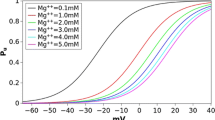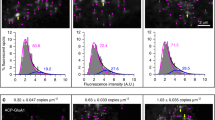Abstract
Coexistence of AMPA and NMDA receptors in glutamatergic synapses leads to a cooperative effect that can be very complex. This effect is dependent on many parameters including the relative and absolute number of the two types of receptors and biophysical parameters that can vary among synapses of the same cell. Herein we simulate the AMPA/NMDA cooperativity by using different number of the two types of receptors and considering the effect of the spine resistance on the EPSC production. Our results show that the relative number of NMDA with respect to AMPA produces a different degree of cooperation which depends also on the spine resistance.












Similar content being viewed by others
References
Ahmad, M., Polepalli, J.S., Goswami, D., Yang, X., Kaeser-Woo, Y.J., Südhof, T.C., & Malenka, R.C. (2012). Postsynaptic complexin controls AMPA receptor exocytosis during LTP. Neuron, 73(2), 260–267. doi:10.1016/j.neuron.2011.11.020.
Auger, C., & Martin, A. (2000). Quantal currents at single-site central synapse. The Journal of Physiology, 526, 3–11.
Beattie, E.C., Carroll, R.C., Yu, X., Morishita, W., Yasuda, H., Von Zastrow, M., & Malenka, R.C. (2000). Regulation of AMPA receptor endocytosis by a signaling mechanism shared with LTD. Nature Neuroscience, 3(12), 1291–1300. doi:10.1038/81823.
Clements, J.D., Lester, R.A., Tong, J., Jahr, C.E., & Westbrook, G.L. (1992). The time course of glutamate in the synaptic cleft. Science, 258, 1498–1501.
Di Maio, V. (2008). Regulation of information passing by synaptic transmission: a short review. Brain Research, 1225, 26–38.
Di Maio, V., Ventriglia, F., & Santillo, S. (2015). A model of Dopamine modulated glutamatergic synaspe. Biosystems, 136, 59–65. doi:10.1002/0470841559.ch1.
Di Maio, V., Ventriglia, F., & Santillo, S. (2016a). A model of cooperative effect of AMPA and NMDA receptors in glutamatergic synapses. Cognitive Neurodynamics. doi:10.1007/s11571-016-9383-3.
Di Maio, V., Ventriglia, F., & Santillo, S. (2016b). A model of Dopamine modulation of glutamatergic synapse on medium size spiny neurons. Biosystems. doi:10.1016/j.biosystems.2016.03.001.
Dingledine, R., Borges, K., Bowie, D., & Traynelis, S. (1999). The gutamate receptor ion channels. Pharmacological Reviews, 51, 7–61.
Forti, L., Bossi, M., Bergamaschi, A., Villa, A., & Malgaroli, A. (1997). Loose path recording of single quanta at individual hippocampal synapses. Nature, 388, 874–878.
Greger, I.H., Ziff, E.B., & Penn, A.C. (2007). Molecular determinants of AMPA receptor subunit assembly. Trends in Neurosciences, 30(8), 407–416. doi:10.1016/j.tins.2007.06.005.
Harnett, M., Makara, J., Spruston, N., Kath, W., & JC, M. (2012). Synaptic amplification by dendritic spines enhances input cooperativity. Nature, 491, 599–602.
Jahr, C., & Stevens, C. (1990). Voltage Dependence of NMDA-Activated macroscopic conductances predicted by single-channel kinetics. The Journal of Neuroscience, 10, 3178–3182.
Kokaia, M. (2000). Long-term potentiation of single subicular neurons in mice. Hippocampus, 10(6), 684–692. doi:10.1002/1098-1063(2000)10:6.
Kupper, J., Ascher, P., & Neyton, J. (1998). Internal M g 2+ block of recombinant NMDA channels mutated within the selectivity filter and expressed in Xenopus oocytes. The Journal of Physiology, 507, 1–12.
Larkman, A.U., & Jack, J.J. (1995). Synaptic plasticity: hippocampal LTP. Current Opinion in Neurobiology, 5(3), 324–334.
Lu, W., Man, H., Ju, W., Trimble, W.S., MacDonald, J.F., & Wang, Y.T. (2001). Activation of synaptic NMDA receptors induces membrane insertion of new AMPA receptors and LTP in cultured hippocampal neurons. Neuron, 29(1), 243–254.
Majewska, A., Tashiro, A., & Yuste, R. (2000). Regulation of spine calcium dynamics by rapid spine motility. The Journal of Neuroscience, 20, 8262–8268.
Malinow, R., & Malenka, R.C. (2002). AMPA receptor trafficking and synaptic plasticity. Annual Review of Neuroscience, 25, 103–126. doi:10.1146/annurev.neuro.25.112701.142758.
Mayer, M.L. (2005). Glutamate receptor ion channels. Current Opinion in Neurobiology, 15, 282–288. doi:10.1016/j.conb.2005.05.004.
Megias, M., Emri, Z., Freund, T.F., & Gulyas, A.I. (2001). Total number and distribution of inhibitory and excitatory synapses on hippocampal CA1 pyramidal cells. Neuroscience, 102, 527– 540.
Meldolesi, J. (1995). Long-term potentiation. The cell biology connection. Current Biology, 5(9), 1006–1008.
Molnár, E. (2011). Long-term potentiation in cultured hippocampal neurons. Seminars in Cell and Developmental Biology, 22(5), 506–513. doi:10.1016/j.semcdb.2011.07.017.
Nicoll, R., & Schmitz, D. (2005). Synaptic plasticity at hippocampal mossy fibre synapses. Nature Reviews Neuroscience, 6, 863–876.
Planert, H., Berger, T., & G S. (2013). Membrane properties of striatal direct and indirect pathway neurons in mouse and rat slices and their modulation by dopamine. Plos One, 8, 1–14.
Rall, W., & Rinzel, J. (1973). Branch input resistance and steady attenuation for input to one branch of a dendritic neuron model. Biophysical Journal, 13, 648–688.
Rao, V.R., & Finkbeiner, S. (2007). NMDA and AMPA receptors: old channels, new tricks. Trends in Neurosciences, 30(6), 284–291. doi:10.1016/j.tins.2007.03.012.
Raymond, C.R. (2007). LTP forms 1, 2 and 3: different mechanisms for the “long” in long-term potentiation. Trends in Neurosciences, 30(4), 167–175. doi:10.1016/j.tins.2007.01.007.
Sanz-Clemente, A., Nicoll, R.A., & Roche, K.W. (2013). Diversity in NMDA receptor composition: many regulators, many consequences. Neuroscientist, 19(1), 62–75. doi:10.1177/1073858411435129.
Schikorski, T., & Stevens, C.F. (1997). Quantitative ultrastructural analysis of hippocampal excitatory synapses. The Journal of Neuroscience, 17, 5858–5867.
Schikorski, T., & Stevens, C.F. (2001). Morphological correlates of functionally defined synaptic vesicle populations. Nature Neuroscience, 4, 391–395.
Segev, I. (1998). Cable and compartmental models of dendritic trees. In Bower, J M, & Beeman, D (Eds.), The book of GENESIS: exploring realistic neural models with the general, neural, simulation systems (pp. 51–78). Whiley.
Tønnesen, J., Rózsa, G., Katona, B., & Nägerl, U. (2014). Spine neck plasticity regulates compartmentalization of synapses. Nature Neuroscience, 17, 678–685.
Traynelis, S., Wollmuth, L., CJ, M., Menniti, F., Vance, K., Ogden, K., Hansen, K., Yuan, H., Myers, S., & Dingledine, R. (2010). Glutamate receptor ion channels: structure, regulation, and function. Pharmacological Reviews, 62, 405–496.
Vargas-Caballero, M.I., & Robinson, H. (2004). Fast and slow voltage-dependent dynamics of magnesium block in the NMDA receptor: The asymmetric trapping block model. The Journal of Neuroscience, 24, 6171–6180.
Ventriglia, F. (2011). Effect of filaments within the synaptic cleft on the response of excitatory synapses simulated by computer experiments. Biosystems, 104, 14–22.
Ventriglia, F., & Di Maio, V. (2000a). A Brownian simulation model of glutamate synaptic diffusion in the femtosecond time scale. Biological Cybernetics, 83, 93–109.
Ventriglia, F., & Di Maio, V. (2000b). A Brownian model of glutamate diffusion in excitatory synapses of hippocampus. Biosystems, 58, 67–74.
Ventriglia, F., & Di Maio, V. (2002). Stochastic fluctuation of the synaptic function. Biosystems, 67, 287–294.
Ventriglia, F., & Di Maio, V. (2003). Stochastic fluctuation of the quantal EPSC amplitude in computer simulated excitatory synapses of hippocampus. Biosystems, 71, 195–204.
Ventriglia, F., & Di Maio, V. (2013a). Effects of AMPARs trafficking and glutamate-receptor binding probability on stochastic variability of EPSC. Biosystems, 112, 298–304.
Ventriglia, F., & Di Maio, V. (2013b). Glutamate-AMPA interaction in a model of synaptic transmission. Brain Research, 1536, 168–176.
Wickens, J. (1988). Electrically coupled but chemically isolated synapses: dendritic spines and calcium in a rule for synaptic modification. Progress in Neurobiology, 31, 507– 528.
Zakharenko, S.S., Zablow, L., & Siegelbaum, S.A. (2001). Visualization of changes in presynaptic function during long-term synaptic plasticity. Nature Neuroscience, 4, 711–717. doi:10.1038/89498.
Zito, K., & Scheuss, V. (2009). NMDA receptor function and physiological modulation. In Squire, L (Ed.), Encyclopedia of neuroscience, (Vol. 6 pp. 1157–1164). Oxford: Academic Press.
Zuber, B., Nikonenko, I., Klauser, P., Muller, D., & Dobochet, J. (2005). The mammallian central nervous synaptic cleft contains a high density of periodically organized complexes. Proceedings of the National Academy of Sciences of the United States of America, 102, 19,192–19,197.
Author information
Authors and Affiliations
Corresponding author
Ethics declarations
Conflict of interest
The authors declare that they have no conflict of interest.
Additional information
Action Editor: Alessandro Treves
Rights and permissions
About this article
Cite this article
Di Maio, V., Ventriglia, F. & Santillo, S. AMPA/NMDA cooperativity and integration during a single synaptic event. J Comput Neurosci 41, 127–142 (2016). https://doi.org/10.1007/s10827-016-0609-5
Received:
Revised:
Accepted:
Published:
Issue Date:
DOI: https://doi.org/10.1007/s10827-016-0609-5




